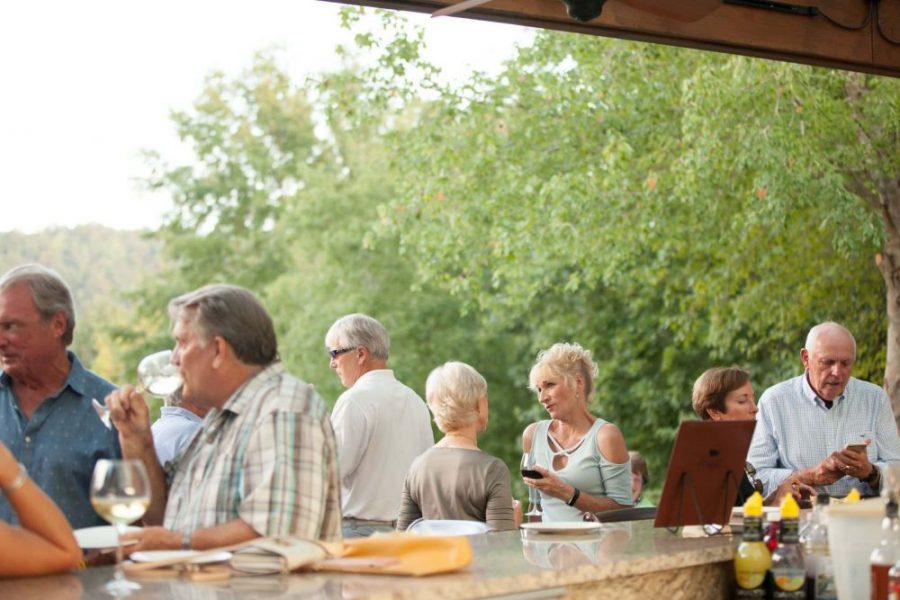Three former military pilots on their flight path: from thrills in the service to chills at The Cliffs.
With a shared history of navigating storms, missiles and dead-of-night landings, it’s easy to assume that all military pilots are adrenaline junkies—but that couldn’t be further from the truth for these three easy-going members at The Cliffs.
Peyton Russell, George Panasuk, and Andrew “Toby” Swasko are cut from the same cloth in only one way: they found just as much camaraderie during their time in the service as they have in their current communities at The Cliffs. Their stories, interests, and aircrafts couldn’t have been more different. Strap in and hold tight—we’re taking to the skies to hear how close calls and pickleball have shaped the momentum of these pilots’ lives.
GEORGE PANASUK
MARINE PILOT, A-4 SKYHAWK
“I wanted to be an astronaut when I was growing up,” says George Panasuk, a retired Marine and commercial pilot. “My dad was a Marine pilot during Korea, and then he went on to fly a career at TWA as a pilot. I didn’t mean to follow in his footsteps, it just kind of happened that way.”
Panasuk went to college on a Naval ROTC scholarship, during which he headed to flight school in Pensacola, Florida, and ultimately earned his wings in early 1980. “I was based up at Cherry Point, North Carolina, for three years and I was between all the wars,” says Panasuk. “Everything I did was essentially preparing for the Cold War against Russia. Every flight was a training flight of some kind, using the Russian defenses [as our target]. Those were the missiles we learned to fight against, all of our ground targets.”
Panasuk flew the A-4 Skyhawk, a single-seat attack airplane. “We deployed twice to Japan. We were over there for a year or so, and every squadron was represented either in Okinawa or Japan to protect both Japan and South Korea, should [forces from North Korea] ever come across the border,” adds Panasuk. “That was the mission: help the RoK [Republic of Korea], Marines, and Air Force defend South Korea.”
It was during this mission that Panasuk encountered his most adrenaline-charged moment. “We were on a training flight in Japan and the airplane had a control malfunction. I had to eject and leave the airplane in a rice patty somewhere in Northern Japan,” reflects Panasuk. “There’s not a lot of fear — you know the procedure by heart. But I remember thinking, ‘I’m in big trouble now.’” When asked if it was because the A-4 was an expensive piece of equipment, Panasuk laughs and admits: “Because they had to pay the Japanese farmer for all the land that was destroyed.”
Panasuk went on to spend two years as a flight instructor in the Advanced Training Squadron in Meridian, Mississippi, before making the decision to become a commercial pilot. “My intent had been to stay in [the military] for a full 20 [years], but then we had kids. My wife and I didn’t want to have to move them every three years, and start over again — plus, the airplane I was flying was being phased out,” says Panasuk, who knew he had a decision to make. “In the long term, for my family, it turned out to be the best choice at the time,” he adds. He would go on to fly for FedEx.
Now retired, Panasuk and his wife stay busier than they’ve ever been. “I really don’t miss the flying,” laughs Panasuk, who chose The Cliffs at Glassy both for the wealth of recreational opportunities and the welcoming community. “We quickly found that there’s a ready-made support system up here, where we’d have no problem staying busy and making friends. [So] we found a piece of land we loved down at the end of Raptor Way, bought it in 2012 and broke ground in September of 2016.”
Instead of flying the skies, today you’ll catch Panasuk playing pickleball, volunteering at the Glassy Mountain Fire Department or going for a ride with a group of other motorcycle enthusiasts. “I’ve always ridden motorcycles, so this is like motorcycle heaven up here,” he says, adding: “I guess motorcycles are my airplanes now. They’re all the adrenaline rush I need.”
ANDREW ‘TOBY’ SWASKO
MARINE PILOT, F-8 CRUSADER
“I’d never been in an airplane, never thought about flying, but it led to a great career,” reflects Toby Swasko, who admits he “was screwing up in college and wasting my father’s money, so I decided to go into the service.” Swasko was accepted into the Marine Corps flight program, where he flew five years under the call sign ‘Guppy,’ before becoming a commercial pilot of 36 years for United Airlines.
“I entered the Marine Aviation Cadet Program in the fall of 1961 and won my Naval Aviator wings in March of 1963,” says Swasko, whose orders sent him to South Carolina, where he flew the F-8 Crusader, the Marine Corps’ first supersonic fighter. “Our squadron deployed frequently to Roosevelt Roads Naval Station, Puerto Rico, and Guantanamo Bay, Cuba, so that we could practice air-to-air gunnery and air-combat maneuvering out over the Caribbean, away from commercial traffic.”
In the early 1960s, Swasko often flew top cover for aircraft intelligence gathering missions off the coast of Cuba. “The airplanes that were gathering intelligence would be at about 20,000 feet, and we’d be at about 35,000 feet over them,” acting as protection against any enemy combatants looking to shoot down the planes. The threat of missiles didn’t compare to the most thrilling part of Swasko’s time flying the F-8, however: night landings on carriers at sea.
“When you talk to a naval aviator about night landings on carriers, the only people that understand what you’re talking about is another guy that’s done it. You just can’t explain it,” says Swasko. “Air Force pilots do the same mission that Navy and Marine Corps pilots do, but when they come back to their base, they come back to a 12,000-foot runway. Naval aviators come back to a 200-foot deck on a carrier,” says Swasko, who remembers all too well the heart-pounding moments spent coming back aboard the USS Saratoga in the dead of night. “We had only enough fuel to make two passes over the ship before we would have to bingo to shore. We’d take off at our max landing weight, not fully loaded, just so we could practice landings. I think I spent four hours in the airplane one night, and when we finished, there was no part of me that wasn’t wet.”
Another adrenaline-soaked memory for Swasko almost ended in “a ball of fire about two miles long,” he laughs. “I had just joined the squadron at Roosevelt Roads, maybe 20 to 30 hours in, and there was a British cruiser anchored nearby that wanted to calibrate its radar. We were supposed to go out about 40 miles from the carrier and make a run in on him at about 500 feet, maybe 450 miles an hour — but I got a little bit carried away. I was actually doing 700 indicated air speed when I looped over him, which is just below being supersonic at sea level. I actuated a device that had a 550 knot limit on it, and it flipped me upside down. So I was doing close to 750 miles an hour, 50 feet over the water, upside down, and I’m really quite lucky it didn’t kill me.”
After his long years with United Airlines, Swasko retired and happily settled into a rewarding life at The Cliffs Valley in 2001. “We love it here,” he says, noting that several other former Marines and neighbors gathered to celebrate the birthday of the Corps on Nov. 10 of last year. “My wife is a native South Carolinian that I met down in Beaufort, and she’s always saying, ‘We’re so lucky that we live here. it’s just beautiful.’ I enjoy golf, she enjoys walking, we enjoy the clubs. The Cliffs runs a first-class operation.”
PEYTON RUSSELL
ARMY HELICOPTER PILOT
“There’s a picture of me when I was 5 years old wearing a World War II pilot uniform for Halloween,” laughs Peyton Russell, a former Army pilot and current FedEx commercial pilot. “I was an army brat, and a lot of my dad’s brothers were in the military. So from an early age — and especially because of my family role models — I wanted to be in the military.”
Growing up, Russell bounced back and forth between the States and Europe before accepting an ROTC scholarship to the Rochester Institute of Technology, where he was assigned to the aviation branch. “I started my career as an Army helicopter pilot, and I did that for about seven years,” reflects Russell. “[Through MAST, or Military Assistance to Safety and Traffic] I flew for an air ambulance company in Fort Rucker, Alabama, and that was really cool — we got to fly into the middle of the highway, to the scene of an accident, and fly patients to hospitals.”
Next, the pilot headed to Germany, where his family ties came full circle. “This is how small the world is: I worked on the same floor of the same building — in the same office — as my dad did 30 years before me, when he was an officer during the Cold War.”
Back in the U.S., Russell spent time teaching at the Army Flight School, where he was a company commander. “That was a fun job, too,” grins Russell, who notes that flying with students keeps you on your toes. “New pilots will do things that you would never expect… I once had a student shut the [helicopter] motor off in mid-air. What started as a simulated engine failure became a real engine failure when he rolled the engine completely off,” he laughs.
The most rewarding chapter of his career, Russell is quick to admit, is what came next: flying helicopters for the Coast Guard as part of a special operations unit. “All we did was counter narcotics. [We were] deployed on ships in the Caribbean and Eastern Pacific, and we chased drug dealers around. It was usually at night, 30 feet above the ground with just night vision goggles. We would use large-caliber weapons and shoot the motors out of the boats to stop them, and would seize large quantities of cocaine and marijuana before it reached the streets of America. It was incredible — a very satisfying job.”
His most thrilling flight ever, however, was when he started flying airplanes in Elizabeth City, North Carolina. “I got to fly into Hurricane Sandy, or ‘Super Storm Sandy,’” the pilot reflects. “The HMS Bounty had left port in Connecticut and sailed right into the middle of that hurricane with 16 people on board. The ship ended up sinking, but we were able to rescue 14 of them. That was probably my most harrowing flight.”
Russell was hired by FedEx in December of 2016, and “I haven’t looked back,” he admits. “It’s probably been the best job of my life.” Russell’s work requires lengthy travel, which makes he and his wife relish their life at The Cliffs — particularly their pickleball league and time spent hiking — all the more. “This is the first time I’ve lived in a neighborhood where I actually feel that sense of community,” he says. “I might be gone a week or eight days, but I feel like I have nothing to worry about. If my wife has a problem with an appliance or the roof leaks, my neighbors will be there in an instant to help her — and that help is sincere, which is absolutely amazing. It’s almost like being in the military again, believe it or not. There’s just a sense of camaraderie here that you don’t get in other places.”
This story was featured in Cliffs Living Magazine. To read more stories like this one and learn more about The Cliffs, subscribe here.





